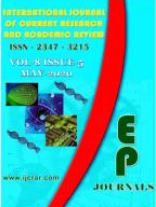Abstract Volume:8 Issue-5 Year-2020 Original Research Articles
 |
Online ISSN : 2347 - 3215 Issues : 12 per year Publisher : Excellent Publishers Email : editorijcret@gmail.com |
Among food-grains, wheat is the most important staple food grain crop and stands next only to rice at global level. Wheat is the third most produced cereal grain in the world after maize 875 million tons and rice 718 million tons with a production of over 674 million tons on over 216 million ha, or 3.1t ha-1 (FAO, 2013). Due to ever-increasing human population and decreased area under cultivation, there is a pressure on limited land resource to meet basic demands of increased population towards food, fodder, pulses, oilseeds etc. The potential to increase arable cropping area is severely limited without significant environmental implications; the way to solving the problem is a sustainable intensification through a re-invigoration of yield improvement by either genetic progress or optimization of cropping systems. Having this idea in mind, it can be conclude that, intercropping systems have the scope and potential to exceed the yields possible in monocultures of their component species and hindering variety of disease development such as rust. It provides a variety of returns from land and labour to the farmers, often increases the efficiency with which scarce resources are used and reduces the failure risk of a single crop that is susceptible to environmental and economic fluctuations. Cropping system based on carefully designed species mixtures reveal many potential advantages interims of enhancing crop productivity, reducing pest and disease, and enhancing ecological service. Associating cereals and legume production through cropping system have a relevant strategy of producing both types of crops while benefiting from combining nitrogen fixed by the legume through symbiotic association with nitrogen fixing bacteria and from better use of phosphorous and water through michrohezial association. Therefore it can be suggested that intercropping wheat with legumes is a desirable agronomic practice towards boosting of yield and prevention of disease incidence such as rust.
How to cite this article:
Mekonnen Gebeyaw. 2020. Review on: Role of Pulse Crop Intercropping with Bread wheat for hindering Rust Disease development and Inmproving Yield performance of Bread Wheat (Triticum aestivum L.).Int.J.Curr.Res.Aca.Rev. 8(5): 17-22doi: https://doi.org/10.20546/ijcrar.2020.805.003



Quick Navigation
- Print Article
- Full Text PDF
- How to Cite this Article
- on Google
- on Google Scholor
- Citation Alert By Google Scholar
